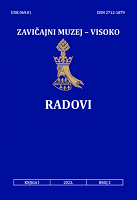Kolekcije fotografija, dopisnih karti i razglednica iz Fototeke Zavičajnog muzeja Visoko - Prilog proučavanju porodice Vojnović iz Visokog
Collection of photographs, correspondence cards and postacards from the Photo library of the Regional Museum in Visoko - Contribution to the study of the Vojnović family in Visoko
Author(s): Habiba Efendira-Čehić, Dženana ArnautovićSubject(s): Anthropology, Museology & Heritage Studies, Photography, Local History / Microhistory, 19th Century, Post-War period (1950 - 1989)
Published by: JU Zavičajni muzej – Visoko
Keywords: photo; postcard; postcard; family album; family photography; the Vojnović family; Visoko; photo collections; legacy of Marica Vojnović; Visoko Native Museum;
Summary/Abstract: Marica Vojnović's legacy has been part of the rich holdings of the Regional Museum in Visoko since 1981. The most valuable part is the photographic material held in two different collections of the muse um: Collection of the photographic material (artwork] from the legacy of M. Vojnović and Collection of the photographic material recorded before the World War II. The Collection of museum photographs and postacards has a value of an anthropological document. Their visual context - photography - reveals a wealth of information on a metaphorical and objective level. The nature of photography is dual because photography itself dwells on the border of subjective and objective perception, i.e. between an artistic and photo-documentary record with characteristics of cultural and historic value. The connection between a family photo and a postcard is that they both act in their own way, in service of both individual and society as a whole. This photographic material represents a family photo album created by exchange of photographies and correspondence between members of the family Vojnović, their relatives and friends from the late 19th to the 1970's of 20th century. The photographic material from M. Vojnović's legacy is valuable as a record the life, culture and customs of one of the Visoko's Orthodox families from the late 19th and early 20th century. By analyzing the photographic material, using historical sources and talking to people who had been in contact with the family Vojnović we were able to produce a remake this story. M. Vojnović (1892-1982] was born in Lika, Croatia. Her uncle, Petar Vojnović (1858 -1930], was a member of the Austro-Hungarian gendarmerie in Visoko, what was the main reason why the family decided to move to Bosnia and Herzegovina in the late 19th or early 20th century. He was married to Ana (-1921 ]. The cousin Milka (-1917 ] also arrived with them. Their immediate family members were the married couple Danilo (1887 -1960] and Natalija (1895 -1979 ] Vojnović who lived in Sarajevo with their children Vojo and Rajka. While she lived in Visoko, M. Vojnović was a member of the Serbian Choral Society "Milutinović" as one of the lead five vocalist of the group and also a member of one of the Visoko's drama groups. It is in evitable to mention that she even sang for the Emperor Francis Joseph I of Austria during his visit to Visoko in 1910. She died in 1982 in the former Retirement Home in Nedžarići, Sarajevo. Unfortunately, to this day we have no information about where M. Vojnović was buried. By describing, analyzing and looking at these photographs we were able to portrey a small part of the M. Vojnović's world. It is a world in which we explore history art, culture, customs, family tree, different family, friendly and business relations, friendly and family gatherings. This is exactly what reveals the power of photography. By preserving the photographic material we also treasure the memories of M. Vojnović.
Journal: Radovi Zavičajnog muzeja - Visoko
- Issue Year: 1/2022
- Issue No: 2
- Page Range: 139-179
- Page Count: 41
- Language: Bosnian

